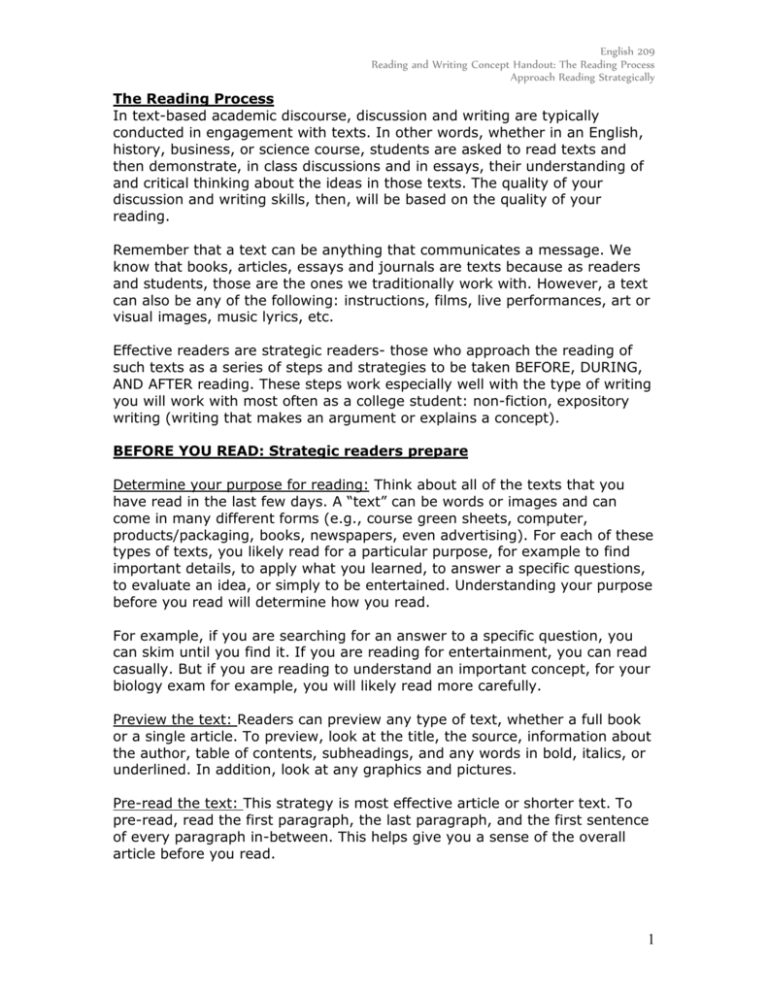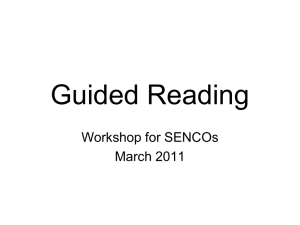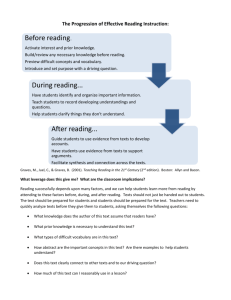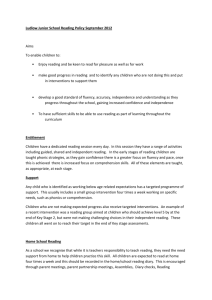Strategic Reading Process: College English Handout
advertisement

English 209 Reading and Writing Concept Handout: The Reading Process Approach Reading Strategically The Reading Process In text-based academic discourse, discussion and writing are typically conducted in engagement with texts. In other words, whether in an English, history, business, or science course, students are asked to read texts and then demonstrate, in class discussions and in essays, their understanding of and critical thinking about the ideas in those texts. The quality of your discussion and writing skills, then, will be based on the quality of your reading. Remember that a text can be anything that communicates a message. We know that books, articles, essays and journals are texts because as readers and students, those are the ones we traditionally work with. However, a text can also be any of the following: instructions, films, live performances, art or visual images, music lyrics, etc. Effective readers are strategic readers- those who approach the reading of such texts as a series of steps and strategies to be taken BEFORE, DURING, AND AFTER reading. These steps work especially well with the type of writing you will work with most often as a college student: non-fiction, expository writing (writing that makes an argument or explains a concept). BEFORE YOU READ: Strategic readers prepare Determine your purpose for reading: Think about all of the texts that you have read in the last few days. A “text” can be words or images and can come in many different forms (e.g., course green sheets, computer, products/packaging, books, newspapers, even advertising). For each of these types of texts, you likely read for a particular purpose, for example to find important details, to apply what you learned, to answer a specific questions, to evaluate an idea, or simply to be entertained. Understanding your purpose before you read will determine how you read. For example, if you are searching for an answer to a specific question, you can skim until you find it. If you are reading for entertainment, you can read casually. But if you are reading to understand an important concept, for your biology exam for example, you will likely read more carefully. Preview the text: Readers can preview any type of text, whether a full book or a single article. To preview, look at the title, the source, information about the author, table of contents, subheadings, and any words in bold, italics, or underlined. In addition, look at any graphics and pictures. Pre-read the text: This strategy is most effective article or shorter text. To pre-read, read the first paragraph, the last paragraph, and the first sentence of every paragraph in-between. This helps give you a sense of the overall article before you read. 1 English 209 Reading and Writing Concept Handout: The Reading Process Approach Reading Strategically Turn the title into a question: After previewing and pre-reading the text, clarify any unknown words or phrases in the title. Then turn the title into a question that you can try to answer as you read. Try to integrate all or part of the title into the question. This question can provide you a focus, and it can also help you make predictions as you read. For example, if the title of the text is: “Killer Illiteracy” (by Ishmael Reed), then a question you might ask is: - How can illiteracy kill? OR - In what ways is illiteracy dangerous? As you can see these types of questions can clearly provide you with a “jump-off” point where you can predict what the author might say. And because these questions are open-ended (meaning they cannot be answered with a simple “yes” or “no”), they can allow you to think about your own experiences and observations to predict the answer to your own question. Make predictions about the text: A good preview and pre-read of a text can help you predict the topic and main points the author will make. To make a prediction, ask yourself, what will be the author’s thesis or central focus? How do I know? Think about your prior knowledge of the topic: One big mistake student readers can make is to assume that they know nothing about a topic and therefore must trust everything that an author says. In reality, everyone has some knowledge, or at least assumptions, about most topics, even remotely. For example, you may not know much about the formal dress of Islamic women, but you likely have some knowledge about clothing and the ways in which it can affect how you are perceived. Thinking about your prior knowledge on a topic before you read can help you relate to the information in the text. By relating to a text, even just a little, you can help yourself stay more focused on this new topic. DURING READING: Strategic readers stay active Find a good reading environment: You may be able to read a magazine at the beach or in bed, but if your purpose for reading is academic, these environments may not work so well. Instead, find a quiet place without distractions, with good lighting, and a good chair/desk for you to sit upright. Hold a pencil: Writing helps make reading more active. Always have a pencil ready to take notes and annotate. Annotate/Code the text! Some students will highlight as they read, but often times this simply leads to a page in your book that is now all yellow instead of white. A more effective approach is to devise a strategy for marking your text. 2 English 209 Reading and Writing Concept Handout: The Reading Process Approach Reading Strategically For example, you can underline main ideas, circle important vocabulary, mark sections/transitions, write questions in the margins, and even write your responses to the author in the margins. You can also use a separate sheet of note paper to keep track of your questions and responses to the author’s ideas if they are in-depth and/or too lengthy for margin notes. AFTER READING: Strategic readers follow through Effective readers both comprehend and reflect on texts. These are two very distinct skills, yet you cannot have one without the other. Comprehension refers to your accurate understanding of what the author says. Reflection refers to your own critical thinking on and evaluation of the author’s ideas. Check Comprehension: Clarify any confusion by checking vocabulary, asking questions (of your classmates and your instructors), and re-reading any areas where you felt lost or confused. To help you make sense of your confusion, you can do any of the following: o If vocabulary is the problem: Use context clues or the dictionary to look up unfamiliar words that seem to be central to the author’s main ideas o If long passages or wordy sentences are the problem: do a closer reading of the section or sections that are most confusing. Break down long sentence by looking at all its parts. o If a particular concept is confusing: write down 1-2 questions about this concept or idea and use this question to ask others for clarification. Identify main ideas and relevant support: what is the author’s thesis or central argument? What major support does the author use to support this thesis? Organize information by writing out an outline or using graphic organizers Write a summary or explain the author’s ideas to someone else Reflect: Relate the author’s ideas to your own experience Ask questions to the author, to yourself, and to your peers Discuss the text with others to gain different interpretations Write a response that allows you to explore the ideas of the writer in more depth and detail If you are using these strategies for the first time, it can seem as though the process takes too much time. But remember, with practice and consistency these strategies will start to become more natural and less time consuming. Ultimately, these strategies will help you develop a deeper understanding of what you read, and using them can lead you towards a smooth transition into participating actively in discussion and writing. 3








